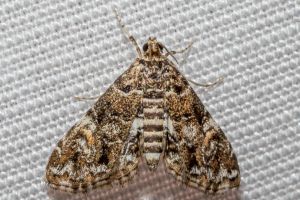

 +2Kontinente:EUAS
+2Kontinente:EUAS1. Lebendfotos
1.1. Falter
2. Weitere Informationen
2.1. Andere Kombinationen
- Nymphula melagynalis Agassiz, 1978 [Originalkombination]
2.2. Verbreitung
Die - wie eine kleine Elophila difflualis aussehende - Art wurde anhand verschleppter Tiere aus Gewächshäusern in Enfield (Großbritannien) beschrieben. Goater (1986) kommentiert: “Recorded uncommonly in the greenhouses at Enfield. Evidently a native of Sri Lanka, Indonesia and other parts of the Far East.” Goater et al. (2005) informieren: “So far only found in Great Britain (Agassiz, 1978: 121). Native to the Oriental Region.” Agassiz et al. (2013: 112) führen die Art bei den "adventive species" und schreiben zu England: "Occasionally imported with aquatic plants, only survives in heated greenhouses. African/ Asian."
Mit einer Etablierung im europäischen Freiland ist angesichts der vermuteten Herkunft der Tiere nicht zu rechnen.
(Autor: Erwin Rennwald)
2.3. Typenmaterial
Agassiz (1978: 123): “Holotype ♀ plus one paratype ♀ from Colombo in the BMNH; additional paratypes from Enfield: 7 ♂, 9 ♀ (including allotype) now in BMNH; 9 ♂, 9 ♀ in collection D. Agassiz with genitalia slide Nos. 216 (♂), 217 & 233 (♀♀); 5 ♂, 3 ♀ in collection B. Goater.”
2.4. Literatur
- Erstbeschreibung: Agassiz, D. (1978): Five introduced species, including one new to science, of China Mark Moths (Lepidoptera: Pyralidae) new to Britain. — Entomologist's Gazette 29: 117-127.
- Agassiz, D.J.L., Beavan, S.D. & R.J. Heckford (2013): Checklist of the Lepidoptera of the British Isles. - Royal Entomological Society. 206pp.
- Goater, B. (1986): British Pyralid Moths. A guide to their identification. — 1-175 + 8 colour plates (Colchester: Harley Books).
- Goater, B., Nuss, M. & Speidel, W. (2005): Pyraloidea I (Crambidae: Acentropinae, Evergestinae, Heliothelinae, Schoenobiinae, Scopariinae). - In: Huemer, P. & Karsholt, O. (Hrsg.): Microlepidoptera of Europe 4: 1-304.




